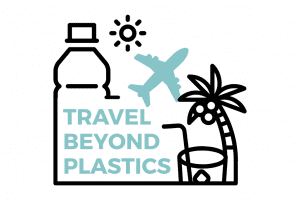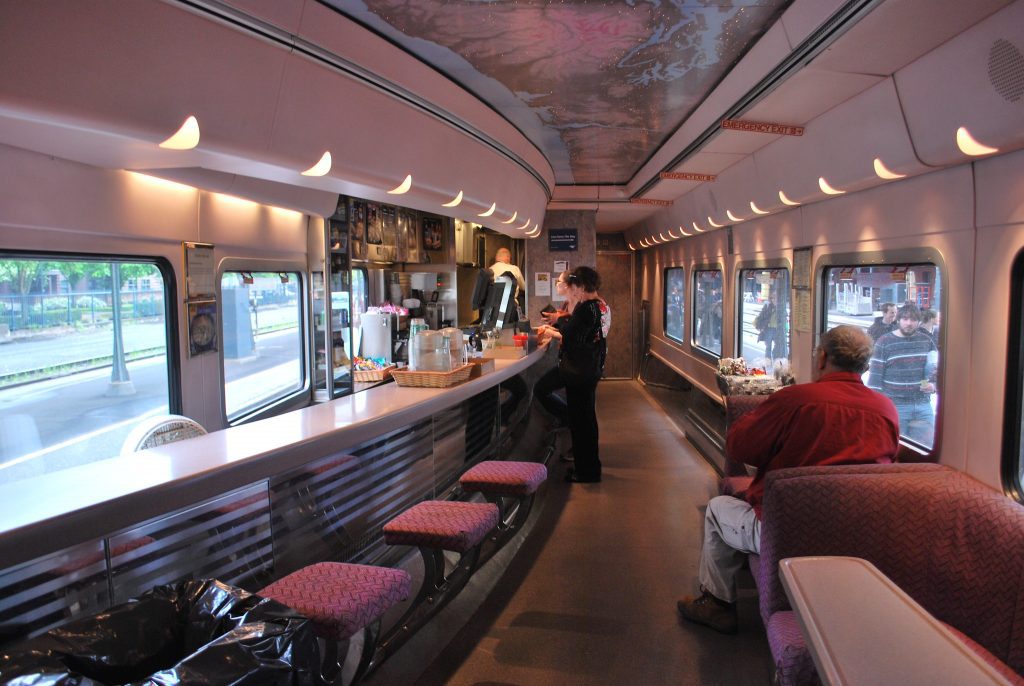Skift Take
Other global rail companies are speeding ahead of Amtrak in reducing single-use plastics, but Amtrak is trying to make up the time.
 Travel Beyond Plastics is a groundbreaking new Skift series about the travel industry’s addiction to plastics and what happens when companies and travelers try to kick this unsustainable habit.
Travel Beyond Plastics is a groundbreaking new Skift series about the travel industry’s addiction to plastics and what happens when companies and travelers try to kick this unsustainable habit.
In mid-October, 20 design students and design professionals boarded an Amtrak train at 30th Street Station in Philadelphia. Their mission on the way to their destination: find ways for Amtrak to reduce its use of single-use plastics.
During the 65-minute workshop, the designers showed off ideas for serving passengers at their seats and in sleeper cars, using sustainable materials.
They included bento boxes for meal service, similar to Japan Rail, wrapping menu items in waxed plastic, aluminum serving pieces that could be sterilized and re-used, and bamboo cutlery, the kind many eco-minded travelers already pack in their carryon bags.
Enthusiasm ran high, said Kara Angotti, senior sustainability manager for Amtrak.
“The response was really stellar,” Angotti added. “People were really into it.”
One caveat the designers faced was safety, added Sierra Prochna, Amtrak’s product development and customer experience lead.
“There are certain restrictions on a train,” she said, which meant designers had to take the security of food and beverages on rail tracks into account.
But Amtrak is running late when it comes to eliminating single-use plastics in meal service, compared with other global rail services. And it doesn’t always do some of the things it is able to do when it comes to recycling.
Walk into one of its café cars, and the first thing you may see is a big tray on top of the counter, filled with individually wrapped plastic forks, knives, and spoons.
Baked goods and snacks still come wrapped in plastic. The most visible green effort spotted was Amtrak’s switch to compostable cold cups that can be recycled. That is, if there is a way to recycle them.
An Amtrak steward on one of my trips told me he sometimes has a box where passengers can dispose of the cups, newspapers and cans, but on that journey, the box hadn’t been put on board.
He promised to recycle an aluminum root beer can if it was brought back to the café car.
And he showed that it is possible to separate plastic lids from coffee cups and recycle them, although passengers can’t do so without that cardboard bin.
Still, officials insist recycling and reducing plastics use is a big topic at Amtrak, whose passengers completed 31.7 million trips in 2018.
Companywide, Amtrak is committed to a recycling goal of 20 percent by 2020, said Olivia Irvin, an Amtrak spokeswoman.
“While we are on track to achieve that goal, we know that there’s always more we can do to divert more away from landfills,” Irvin said in an email statement.
She said the rail company is “investigating options” from vendors to reduce single-use plastic, and to help reduce waste on board in food service packaging and service items — the reason why it held the Philadelphia session, known as a “charette” in design terms.
In a July 2018 survey of 12,250 passengers, 69 percent told the rail company that they were personally interested in recycling.
But it’s evident the company isn’t making it easy for them to do so. Just 27 percent remembered seeing recycling efforts on board its trains. And only 26 percent said it was easy to find a cardboard recycling container (maybe because it wasn’t there).
Compare that with Via Rail in Canada, where a countrywide ban on single-use plastics is set to take place in 2021.
Under its Sustainable Mobility Plan, Via began to reduce single-use plastics in 2018, replacing plastic straws and coffee stirrer sticks with a paper-based and wood-based substitute, said Karl-Philip Marchand Giguere, a Via spokesman.
That same year, it audited all the products used on its trains, hoping to find ways to reduce its overall environmental footprint.
For the future, Via plans to eliminate single-use plastic cups and glasses in its business class service, he said.
The rail line also plans to develop on-board collection and sorting capabilities, so that it can maximize recycling and reduce waste.
Via, like other Canadian companies, doesn’t have much choice, given the nation’s looming ban on single-use plastics.
But, they don’t yet know everything that they will be required to do.
During his party’s election campaign earlier this month, Prime Minister Justin Trudeau was pushed by reporters to be more specific about the proposal.
He replied that he was using a science-based approach, aiming for solutions that would eliminate plastics use without hurting Canadian communities or businesses, but didn’t offer more details.
However, Trudeau, and Amtrak, have other examples around the world that can show them how it can be done.
On Oct. 2, Indian Railways implemented a ban on single-use plastics, with less than a 50 micron thickness.
Bottle-crushing machines are being installed at rail stations, vendors have been directed to avoid using plastic bags for deliveries, and railway staff are using recyclable tote bags.
Meanwhile, Britain’s Network Rail, which operates some of the nation’s busiest stations, is banning plastic cups and cutlery at its stations, beginning in 2020.
Network Rail stations serve more than 20 million cups of coffee and 4 million bottles of water at its stations each year.
It recently began installing water fountains so that passengers can fill water bottles at stations such as Charing Cross in London, as well as stations in Liverpool, Birmingham and Manchester.
Rail lines across Europe also are expected to strip trains and stations of single-use plastic, once the European Union’s ban on single-use plastics takes effect in 2025.
If it seems like Amtrak will have to accelerate to catch up with other rail companies, remember that for decades, American trains had very little single-use plastic, if any.
Railroad dining cars used to abound with china, silverware and glassware, now considered treasures to collectors.
And, given the excitement displayed by the designers at the Philadelphia event, Amtrak’s Angotti sees possibilities for a future in which less single-use plastic is a reality.
It was “nice to see their curiosity of how things work … and understanding and thinking about the challenges we’re facing,” she said.
The Daily Newsletter
Our daily coverage of the global travel industry. Written by editors and analysts from across Skift’s brands.
Have a confidential tip for Skift? Get in touch
Tags: amtrak, travel beyond plastics
Photo credit: Inside the cafe car on Amtrak Cascades. Efforts are under way to curb single-use plastic uses on trains for food and beverage. The West End / Flickr.com
